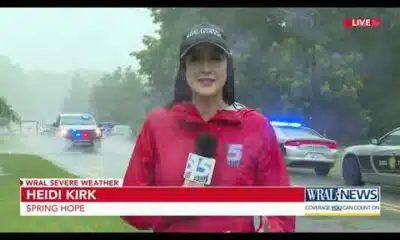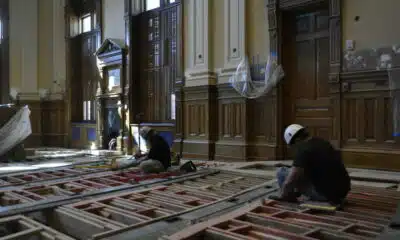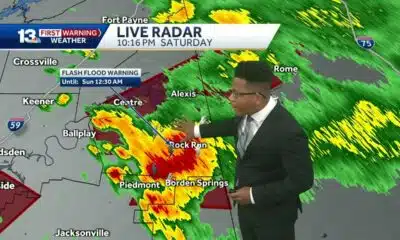News from the South - West Virginia News Feed
Braden's April 2 Forecast
SUMMARY: Braden’s April 2 Forecast indicates a pleasant Wednesday afternoon with temperatures ranging from the 50s to 60s across the region. While areas like Pocahontas County will remain cooler, temperatures are expected to rise into the mid to upper 70s by Friday and low 80s by Saturday, signifying a shift towards summer-like conditions. A mild day is forecasted with gusty winds, though scattered showers and storms may appear Thursday into Friday. However, heavy rainfall is predicted to remain west of the area. Overall, expect mostly sunny conditions, mid-60s highs, and dry weather returning by Saturday.
FOLLOW US ON FACEBOOK AND TWITTER:
https://facebook.com/WOAYNewsWatch
https://twitter.com/WOAYNewsWatch
News from the South - West Virginia News Feed
Katie's August 6 Evening Forecast
SUMMARY: Katie’s August 6 Evening Forecast reports a comfortable, humid Wednesday evening with humidity above 50% in most areas except Summersville at 49%. Temperatures will drop into the 70s and 60s overnight. Tonight remains mostly dry with clouds to the east. Tomorrow may bring scattered sprinkles from lunchtime through evening, but no major disruptions expected. Temperatures will be slightly cooler than usual, in the mid to upper 70s. The weekend promises pleasant weather with highs around 80-82°F, perfect for outdoor events and the fair. Overall, no major weather problems are expected in the coming days.
FOLLOW US ON FACEBOOK AND TWITTER:
https://facebook.com/WOAYNewsWatch
https://twitter.com/WOAYNewsWatch
News from the South - West Virginia News Feed
Historically redlined communities have slower EMS response times
by Nada Hassanein, West Virginia Watch
August 5, 2025
Residents of historically redlined communities experience slower response times from emergency medical services, according to a study published Tuesday in JAMA Network Open.
Redlining refers to the discriminatory practice under which the federal government and banks systematically denied mortgages to Black and Hispanic residents. The practice deemed neighborhoods with higher proportions of nonwhite residents to be undesirable and financially risky for mortgage lending.
Researchers mapped locations of EMS centers across 236 cities and analyzed maps produced in the 1930s by the Home Owners’ Loan Corporation. The government agency, created as part of the New Deal, consistently ranked majority-Black areas as “hazardous” for lending. Redlining has been illegal since enactment of the federal Fair Housing Act in 1968.
The research team calculated average EMS response times using the location of ambulance, fire and rescue services and historical traffic data. “Rapid” response was defined as five minutes or less, the benchmark set by the National Fire Protection Association for high-priority patients with life-threatening conditions.
The team found that more than 2.2 million people lack rapid EMS access. Areas historically graded “D” — financially “hazardous” for mortgage lending — had a significantly higher proportion of residents (roughly 7%) without rapid EMS access, compared with about 4% of residents in historically “most desirable” A-graded neighborhoods. D-graded neighborhoods had higher proportions of Black residents, whereas A-graded neighborhoods had more white residents.
Disparities were particularly acute in the Great Lakes region, the authors note. The odds of lacking rapid access to EMS were nearly three times higher for residents in historically D-graded neighborhoods, compared with A-graded neighborhoods in that region.
The findings add to the evidence linking policies rooted in structural racism to health disparities.
Research has shown redlined neighborhoods still disproportionately grapple with a multitude of health disparities, lower life expectancy and more exposure to air pollution.
The study found a racial disparity in where EMS stations are located, with fewer EMS stations in urban communities of color. Better tracking and accountability of EMS response times in communities could help address the issue, the researchers wrote.
Delays in emergency care are associated with higher mortality rates. For traumatic injuries, timely care is critical during what EMS professionals call the “golden hour,” or the first 60 minutes after an injury.
Other research has pointed to disparities in emergency response times. EMS response times for patients with cardiac arrest, for example, were 10% longer for low-income ZIP codes than high-income ZIP codes, according to a national study published in JAMA Network Open in 2018.
The study received funding support from the National Institutes of Health’s National Institute of Minority Health and Health Disparities.
Stateline reporter Nada Hassanein can be reached at nhassanein@stateline.org.
West Virginia Watch is part of States Newsroom, a nonprofit news network supported by grants and a coalition of donors as a 501c(3) public charity. West Virginia Watch maintains editorial independence. Contact Editor Leann Ray for questions: info@westvirginiawatch.com.
The post Historically redlined communities have slower EMS response times appeared first on westvirginiawatch.com
Note: The following A.I. based commentary is not part of the original article, reproduced above, but is offered in the hopes that it will promote greater media literacy and critical thinking, by making any potential bias more visible to the reader –Staff Editor.
Political Bias Rating: Center-Left
This content presents a fact-based exploration of how historical redlining—an explicitly racial and economic discriminatory practice—continues to impact disparities in emergency medical service response times. It highlights systemic inequalities and racial disparities consistent with social justice concerns more frequently emphasized in center-left discourse. The piece supports the view that structural racism has long-term effects and implicitly advocates for policy attention and accountability in emergency services, aligning with a center-left perspective on addressing inequality and promoting equity in public services. However, it maintains a measured tone and relies heavily on research and data, avoiding overt partisan rhetoric.
News from the South - West Virginia News Feed
Boone St. crossing unsafe to walk across
SUMMARY: A coal train with 220 cars, weighing 54 million pounds, derailed late Saturday night in Saint Albans. Due to the derailment, the police department warns that the crossing at the Boone Street tunnel is unsafe for pedestrians. CSX, the railroad company, states that track repair equipment will be moved periodically through the area, further increasing the hazard. Residents are strongly advised not to walk across the Boone Street crossing until repairs are completed and it is deemed safe. Authorities continue monitoring the situation to ensure public safety during the ongoing repair work.
Boone St. crossing unsafe to walk across
For more Local News from WSAZ: https://www.wsaz.com/
For more YouTube Content: https://www.youtube.com/channel/UCrcuU0JXXy8oIBqEB13mrwA
-
Mississippi Today5 days ago
After 30 years in prison, Mississippi woman dies from cancer she says was preventable
-
News from the South - Georgia News Feed6 days ago
Woman charged after boy in state’s custody dies in hot car
-
News from the South - Texas News Feed5 days ago
Texas redistricting: What to know about Dems’ quorum break
-
News from the South - North Carolina News Feed3 days ago
Two people unaccounted for in Spring Lake after flash flooding
-
News from the South - Florida News Feed6 days ago
Warning for social media shoppers after $22K RV scam
-
News from the South - Texas News Feed7 days ago
Texas VFW holds memorial service for WWII pilot from Georgetown
-
News from the South - Georgia News Feed6 days ago
Georgia lawmakers to return this winter to Capitol chambers refreshed with 19th Century details
-
News from the South - Alabama News Feed7 days ago
Flood Watch for Alabama: Storms linger overnight, with cooler weather in the forecast







































